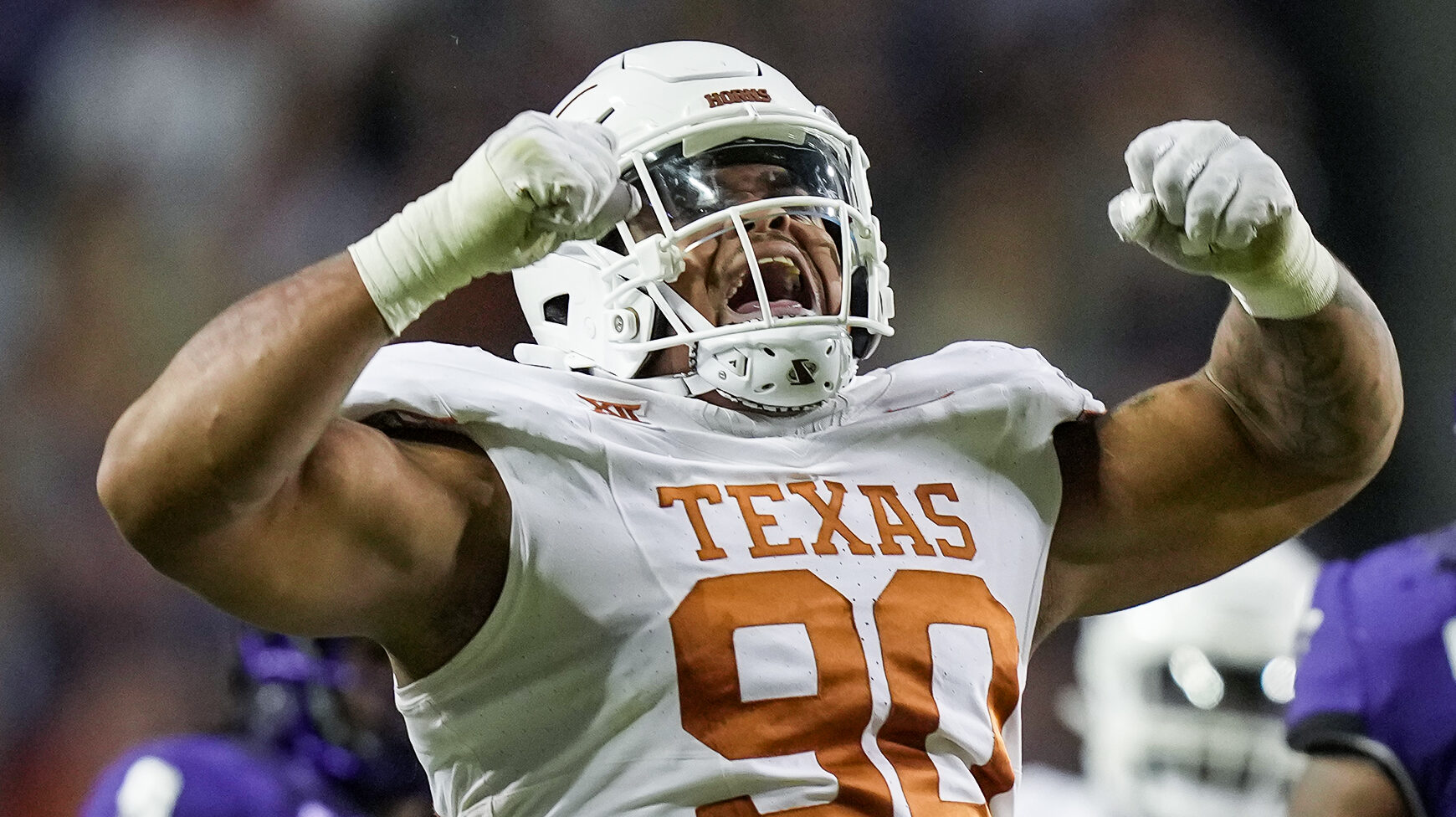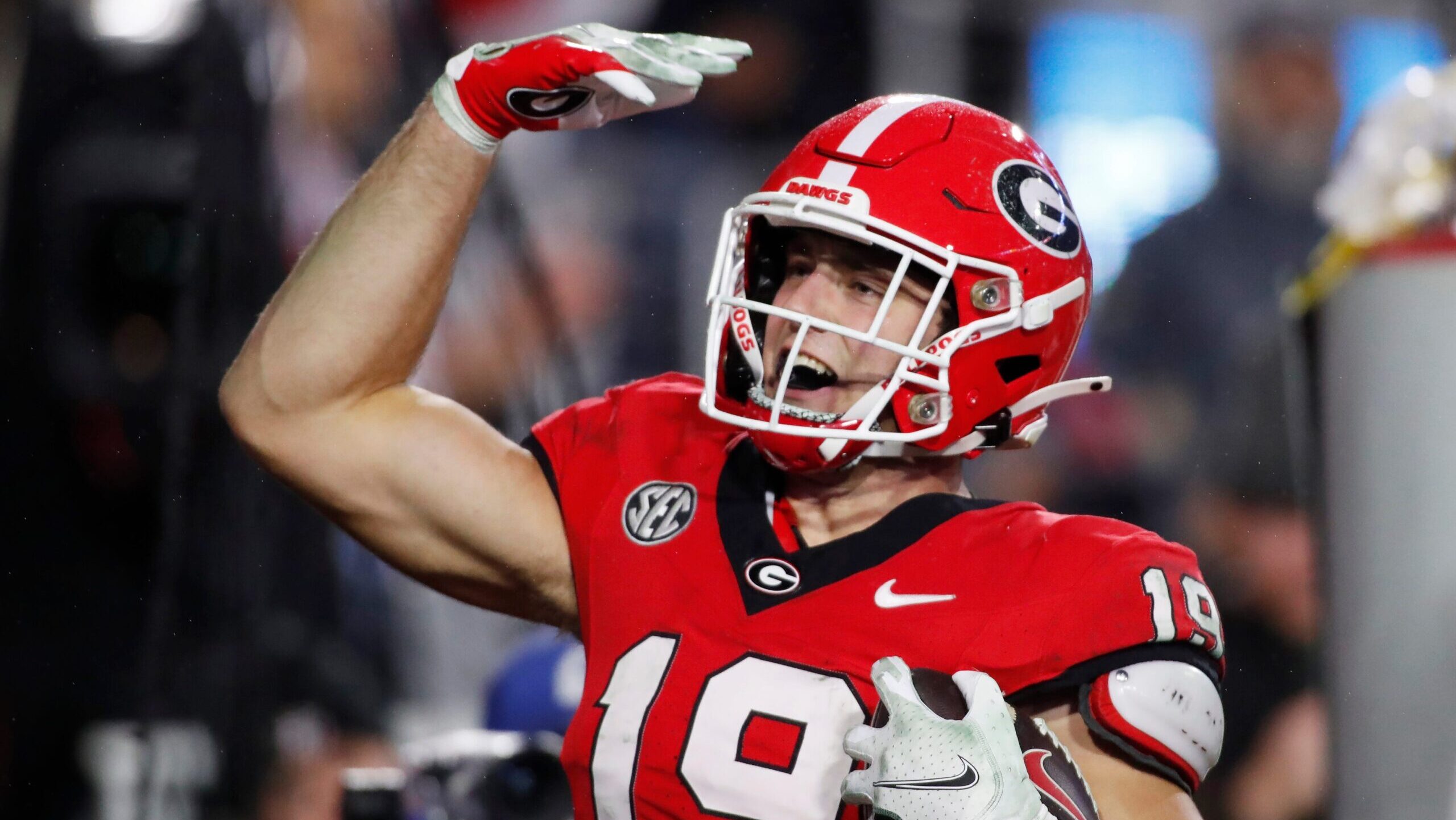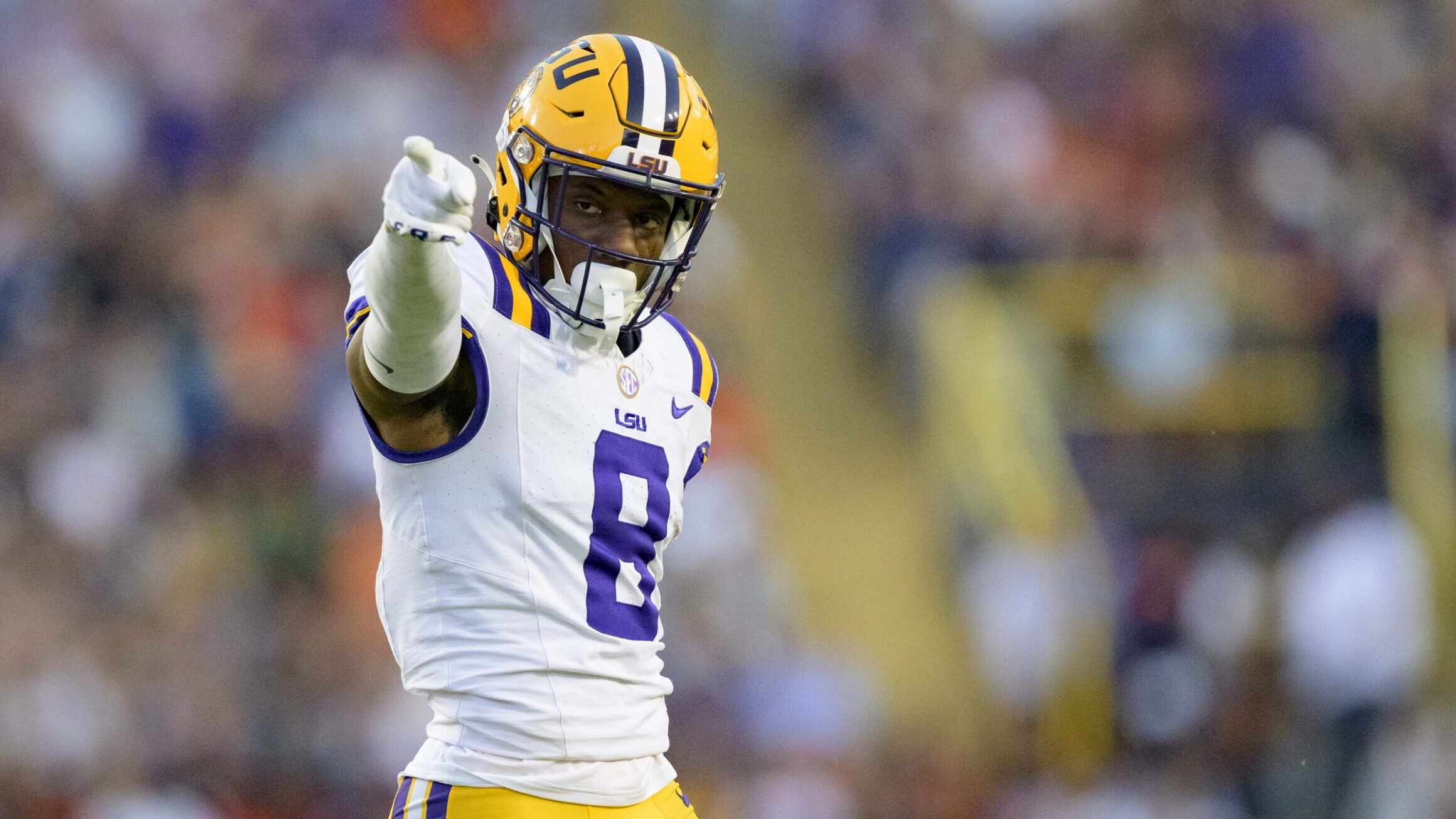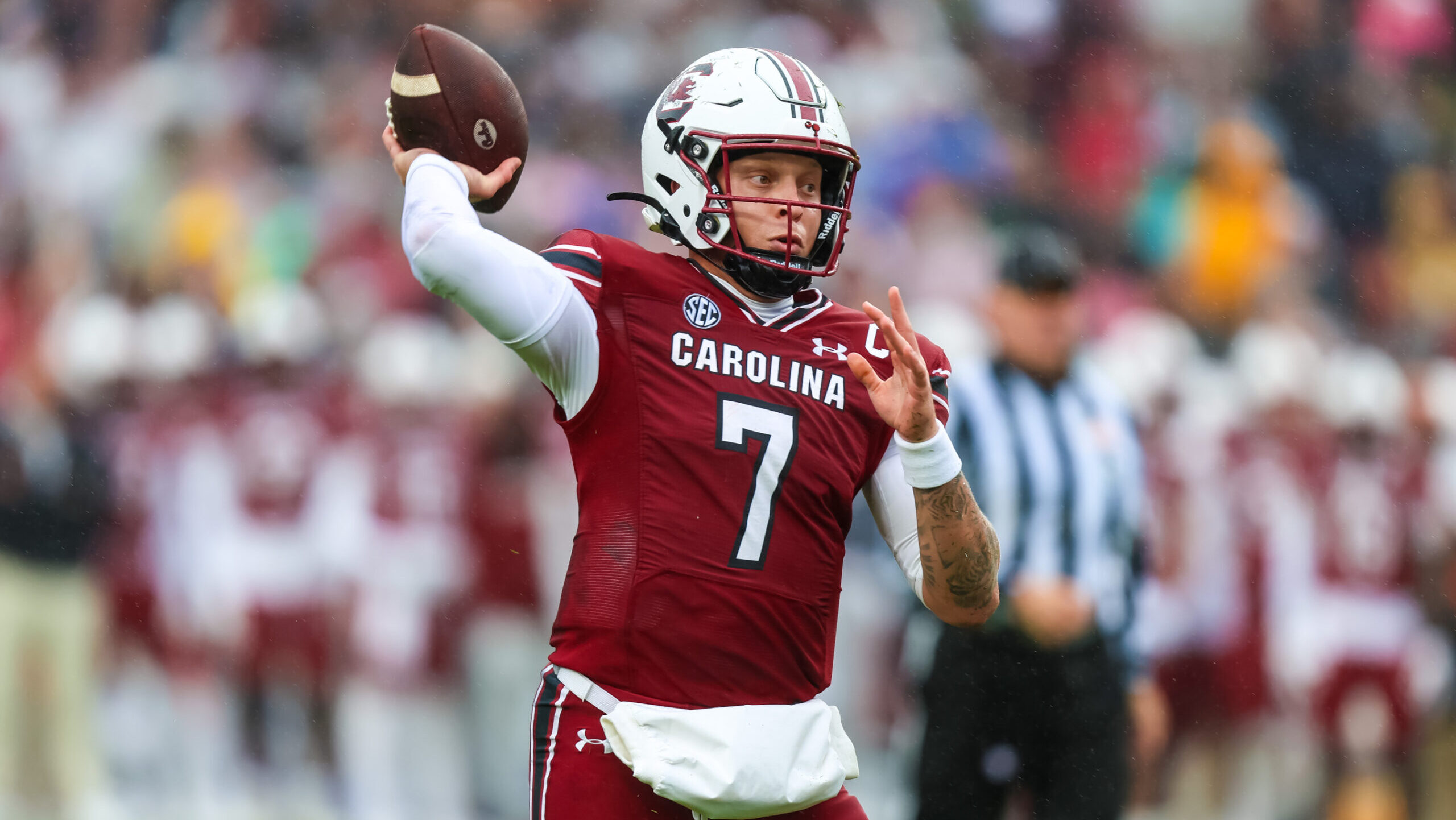Analysis
7/31/22
27 min read
Which NFL Teams Have the Greatest Legacy at Each Offensive Position?
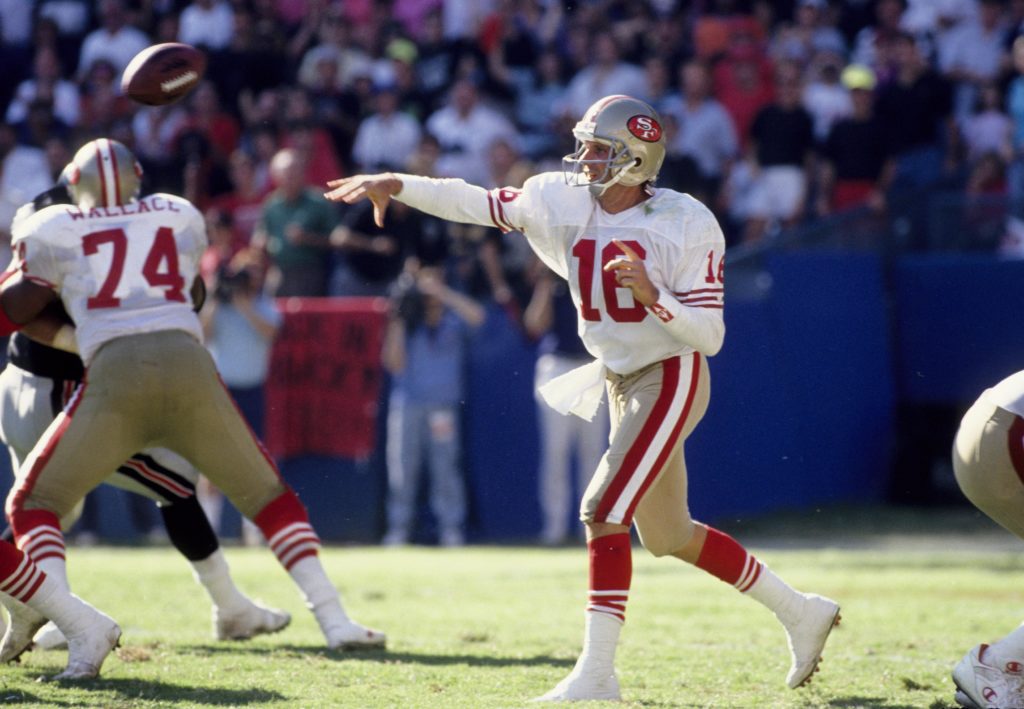
When thinking about the NFL teams with the greatest legacy at each offensive position, does the Rams' timeline of continuous stars at running back from Dickerson, to Bettis, to Faulk, to Jackson, to Gurley come to mind?
Which teams have the greatest legacy for quarterbacks? Some younger fans reading this haven’t been alive during a time when the Packers didn’t have a Hall of Fame quarterback running the offense. The greatest wide receiver of all time, Jerry Rice, is a monumental part of the 49er’s tradition of pass-catchers, but he wasn’t the only one contributing to their exceptional legacy. The Steelers' historical strength on the offensive line is carried by an extraordinary number of noteworthy centers.
For this analysis, we sorted through the statistics and accolades of players from 1970 to the present and calculated the average annual number of Pro Bowlers, first-team AP All-Pros, and Hall of Famers by franchise and by positional group to determine which teams were the best at each position.
The teams we listed are the teams we believe have the greatest legacy at each offensive position in the past 50+ years. This is the second of our two-part series. In the first article, we covered the greatest positional legacy at each defensive position.
Notes:
- All references to All-Pro are first-team Associated Press All-Pro only
- HOF seasons for each team are tabulated only from the season the player played for each team (example: Washington gets 5 Champ Bailey seasons, Denver gets 10)
Quarterback
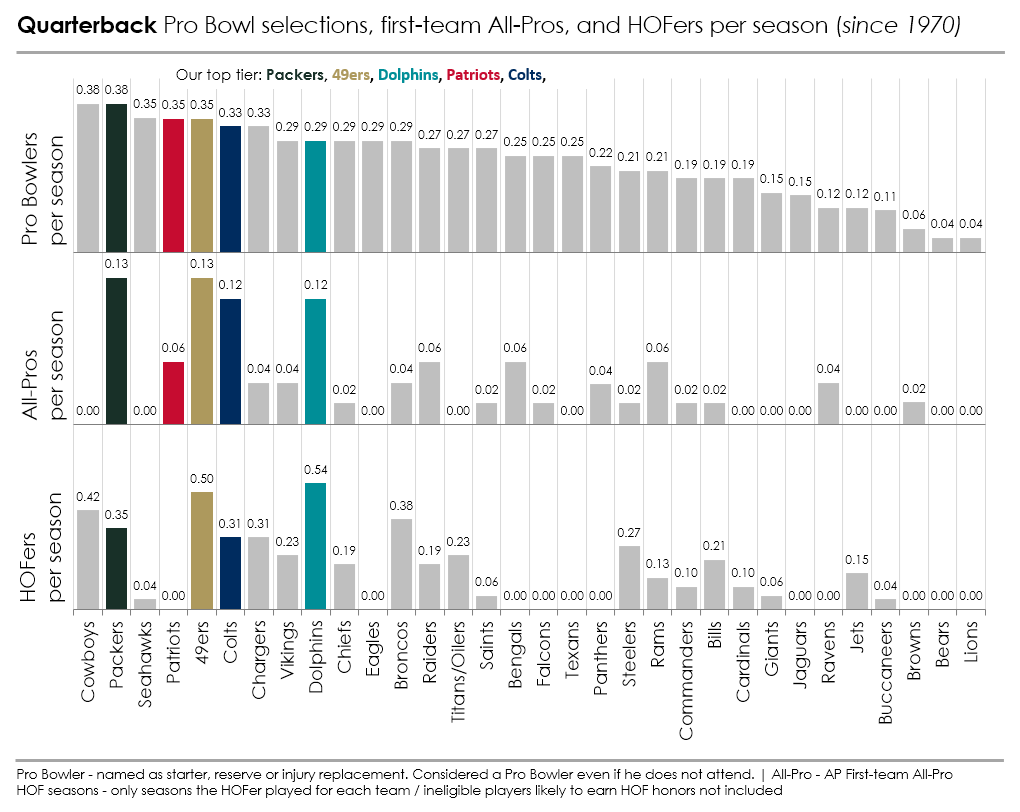
Green Bay Packers
In 1991, the Packers went 4-12 with Don Majkowski and Mike Tomczak as their starting quarterbacks. The U.S.S.R still existed for most of 1991. The number one song was Everything I Do I Do it For You by Bryan Adams. The average price for a gallon of gas in the U.S. was $1.10. This was 31 years ago, and it was also the last time the Green Bay Packers didn’t have a Hall of Fame quarterback (Aaron Rodgers isn’t eligible but is certain to make it).
During the last 31 years, Hall of Famer Brett Favre and future Hall of Famer Aaron Rodgers combined to make nineteen Pro Bowls, seven first-team AP All-Pros, seven league MVP awards, along with a Super Bowl win for each. After the Falcons traded Favre to the Packers in 1992, Favre immediately became a Pro Bowler in his first year as a starter.
Three years later in 1995, he won his first of three consecutive league MVP awards. During those MVP years (1995-1997), he led the Packers to two Super Bowls, winning one, a 35-21 win over the Patriots in Super Bowl XXXI. He amassed 71,838 yards and 508 passing touchdowns, both ranked fourth all-time.
Farve’s replacement in Green Bay, Rodgers, ranks In fifth all-time for touchdowns with 449. After sitting on the bench for three years behind Favre, Rodgers took over in 2008. For the next fourteen years, Rodgers would lead a top-five offense seven times, while the Packers would go 145-78-2 with a Super Bowl win. Rodgers, one of the most efficient quarterbacks ever, has a career interception rate of 1.3%, the lowest rate in NFL history.
His career passer rating of 104.5 is the second highest ever. Although his passer rating benefits from the modern game, he still excels amongst his peers, leading the league in passer rating four times. The post-merger era began with an aging Green Bay legend and Hall of Famer Bart Starr in 1970 and is book-ended by Rodgers, who only seems to be getting better in his later years. Two of his best seasons have come the last two years winning consecutive NFL MVP awards at the ages of 37 and 38.
San Francisco 49ers
When Hall of Famer Joe Montana retired after the 1994 season, he was considered by many as the best. There have not been many nicknames more fitting to a player than “Joe Cool” as he performed better when the pressure increased.
Because of the quality of defenses, a quarterback faces in the playoffs, it’s normal even for the best quarterbacks to see their efficiency decline in the playoffs. But Montana’s passer rating increased by 3.3 points compared to the regular season. The brighter the lights, the better he played, and we can see this by looking at his passer rating, which improve from 85.0 in the Wild Card round, to 88.8 in the Divisional Round, to 92.0 in the Conference Championship and ending at 127.8 in the Super Bowl where he holds a 4-0 record.
In those four Super Bowls, he owns three MVPs and threw for 11 touchdowns vs zero interceptions. During his time with the 49ers, he led the league in completion percentage more than a third of the time and won back-to-back AP MVPs in 1989-90. He retired from the NFL fourth all-time in passing yards (40,551), fourth in passing TDs (273) and with the second-best career passer rating (92.3) at the time.
Sitting on the bench backing up Montana for four years was another future Hall of Famer, Steve Young. It wouldn’t take long for Young to transition from four years on the bench to demonstrating his Hall of Fame credentials on the field.
In his first season as a starter with the 49ers, he led the league in passer rating, he followed that up by leading the league in passer rating for five of the next six seasons including a single-season record at the time (112.8 in 1994). He would match Montana’s two MVPs with two of his own and make the Pro Bowl in seven of his eight years starting along with three first-team AP All-Pros.
From 1991-1998 as the team’s starter, he propelled the 49ers to a top five scoring offense in each of his eight seasons, including the number one position four years in a row. His one trip to the Super Bowl as a starter ended with him throwing for a Super Bowl record six touchdowns and leading the 49ers to a 49-26 win over the Chargers in Super Bowl XXIX.
Montana and Young, place the 49ers in the top tier. But other good quarterbacks help separate them from the pack even further. The post-merger era began with John Brodie winning the league MVP in 1970 for the 49ers. Jeff Garcia had three strong Pro Bowl seasons for the 49ers from 2000-2002.
But it is the 18 seasons from 1981 to 1998 that put the 49ers on the Mount Rushmore of positional legacies. During those 18 seasons, the 49ers' offense is unmatched, with four combined league MVPs, a Pro Bowl quarterback 14 times, a top ten scoring offense all 18 seasons, reaching the playoffs 16 times and going 5-0 in the Super Bowl.
Miami Dolphins
For more than half of the Dolphin’s seasons since the merger, they’ve had a Hall of Fame quarterback. Bob Griese wasn’t a high-volume passer, but he didn’t need to be, with a slew of outstanding running backs to hand the ball off to in Larry Csonka, Jim Kiick and Mercury Morris, and he had a top-five defense.
But, he was an efficient quarterback who earned eight Pro Bowl selections and two first-team All-Pros. Griese played in three consecutive Super Bowls, losing Super Bowl VI to the Cowboys, but then capping off the famous undefeated 1972 season with a Super Bowl win over Washington, followed by another Super Bowl win in 1973. After his career ended, the Dolphins only had to wait three seasons for the next Hall of Fame quarterback, Dan Marino.
In just his second year, at the age of 23, Marino shattered the record books on his way to winning the NFL MVP award. He became the first quarterback to throw for 5,000 yards in a season, and the first quarterback to pass for more than 40 touchdowns (48) in a season. His 1984 season ranks as the second best individual passing season since the merger when adjusted for era.
That season, the Dolphins reached Super Bowl XIX and lost to the 49ers 38-16. Marino ended up playing 17 seasons with the Dolphins and was top five in the league in passing yards eleven times, leading the league five times. The nine-time Pro Bowler and three-time first-team All-Pro retired as the career passing leader in attempts, completions, yards and touchdowns.
A case can be made for…
New England Patriots
Key Players: Tom Brady (HOFer upon eligibility), Drew Bledsoe
Indianapolis Colts
Key Players: Peyton Manning (HOF), Johnny Unitas (HOF; late career post-merger), Andrew Luck
Running back
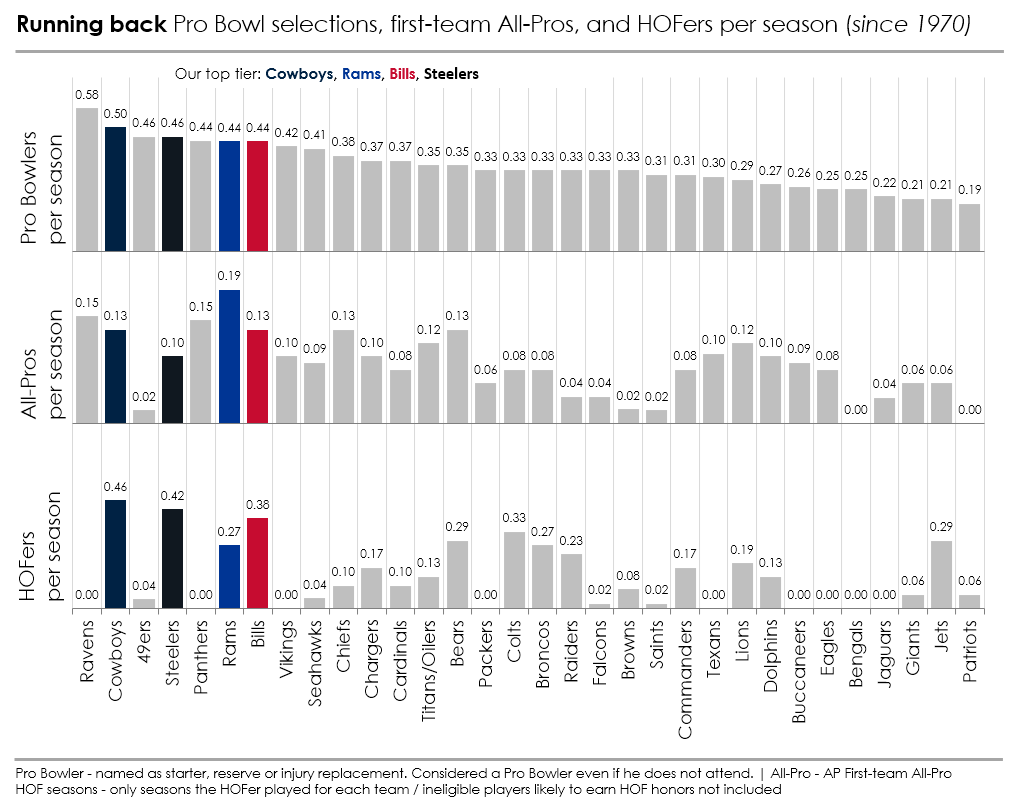
Dallas Cowboys
There are many ways to determine the best running back of all time, and there are, at minimum, five running backs with a case. One obvious criterion to determine the best running back is rushing yards, and by this metric, Emmitt Smith is the greatest back of all time.
His record of 18,355 rushing yards should stand for a long time, as there are no active running backs threatening this record any time soon. The Cowboys' first-round draft pick out of Florida in 1990, made an immediate impact by winning the Rookie of the Year in 1990. Then, during the next five seasons, he ran for over 8,000 yards while leading the league in rushing yards four times and rushing touchdowns three times.
He earned an NFL MVP and four first-team AP All-Pros during those five seasons. During Emmitt’s most dominant years from 1991-1995, the Cowboys never won fewer than 11 regular season games. They made the playoffs every year and won three Super Bowls. The Cowboys counted on Smith’s durability as ran for 1,000 yards in 11 consecutive years, with three coming after the age of 30.
Before Smith, Dallas already had a long tradition of talented running backs with 4-time Pro Bowl running back Calvin Hill in the early 70s, and Hall of Fame back Tony Dorsett in the late 70s and into the late 80s.
Just like Smith, Dorsett contributed early in his career by winning the Rookie of the Year in 1977. His rookie season ended with a rushing touchdown in Super Bowl XII as the Cowboys beat the Broncos 27-10.
Today, the tradition continues with Ezekiel Elliott. Although Elliott has shown signs of slowing down, history suggests that a bounce-back is not out of the question. His league-leading 1,631 rushing yards in his rookie year are the third most by a rookie in history behind only Eric Dickerson and George Rogers.
Since he entered the league, he has made three Pro Bowls, won the rushing title twice and averages 84 running yards per game, the third highest per-game total in the league.
The league-leading 24 seasons with a Hall of Fame running back since the merger, has been a significant reason for the success and popularity of the team historically known as “America’s Team”
Los Angeles/St. Louis Rams
Hall of Famer Marshall Faulk, Hall of Famer Eric Dickerson, first-team All-Pro Todd Gurley and Pro Bowler Steven Jackson have combined for eight individual seasons with 2,000 or more yards from scrimmage with the Rams. Since the merger, the Rams have averaged a 2,000-yard scrimmage season every 6.5 years. For comparison, the rest of the NFL averages a 2K scrimmage season once every 24 years.
If anyone asks which running back on the Rams made the most Pro Bowls as a Ram, it’s likely their guess would come from the list above. It’s also likely they would be wrong. The answer is Lawrence McCutcheon. From 1973 to 1977, McCutcheon made the Pro Bowl five consecutive seasons. During these five years, the Rams were a top-five scoring offense three times and won their division all five seasons on their way to seven straight NFC West division titles.
A few years later, highly-drafted running back Eric Dickerson would more than meet the expectations that came with the second overall pick. In his only four full seasons with the Rams, he ran for 6,968 yards, more yards than any player in history in their first four seasons. His 1,808 yards as a rookie in 1983 still stands 38 years later as the rookie record. He won the Rookie of the Year, earned three Pro Bowls and three first-team All-Pros with the Rams from 1983 to 1986.
Before the 1999 season, the Rams traded for Marshall Faulk which led to the creation of an offensive juggernaut known as “The Greatest Show on Turf.” They would lead the NFL in scoring at nearly 33 points per game and win a Super Bowl. Faulk’s 2,429 yards from scrimmage in 1999 set a new single-season record. The next season, he won the league MVP with another 2,000-yard scrimmage season and a league-leading 26 touchdowns, followed by a third consecutive 2K-yard season with the Rams in 2001.
The Greatest Show on Turf was the number one offense in both scoring and yards for three consecutive seasons during Faulk’s prime years from 1999-2001, all of which he was a first-team All-Pro.
In addition to their record-setting Hall of Fame running backs, the Rams also had Jerome Bettis for a few seasons, who earned a first-team All-Pro selection early in his career with the Rams, they enjoyed multiple All-Pro seasons from Todd Gurley and benefited from eight consecutive 1,000-yard rushing seasons from Pro Bowler Steven Jackson.
Buffalo Bills
The early 1990 Bills won four consecutive AFC Championships…and famously lost four consecutive Super Bowls. The Bills ending up on the wrong side of the final score four years in a row often takes the historical shine off one of the NFL’s more talented teams.
Joining the triumvirate of Hall of Famers Bruce Smith and Jim Kelly, was one of the most versatile running backs in history, Thurman Thomas. During his peak seasons from 1989-1993, Thomas led the NFL in yards from scrimmage for four consecutive seasons, made five Pro Bowls, earned two first-team All-Pros and was the NFL MVP in 1991.
It was during his peak when the Bills put together their best offensive dynasty since the merger, ending up top five in scoring for four consecutive years. Thomas’ productivity didn’t end at his peak, as he strung together eight consecutive 1,000-yard rushing seasons through age 30 and ended his career with over 16,532 yards from scrimmage (10th best for RBs).
Since Thomas, there has been a lack of sustained excellence, but the Bills have been peppered with very good running backs like LeSean McCoy, Travis Henry and a young Marshawn Lynch. The early 80s Bills also had three-time Pro Bowler Joe Cribbs. But the post-merger Bills running game legacy must begin with O.J. Simpson.
Major off-the-field scandals aside, Simpson’s prime was one of the best in NFL history. There have been only eight running backs who have rushed for 2,000 yards in a season. In 1973, Simpson was the first to run for 2,000 yards, and the only one to accomplish this feat in the 14-game era. From 1972-1976 he led the NFL in rushing four times, was selected first-team AP All-Pro all five years, and won a league MVP in 1973.
His career got off to a slow start as he was underused during his first three seasons, and in 1977 at the age of thirty, he hit a wall and declined significantly. His playing career is remembered mostly for those five prime seasons from ’72-’76 when he ran for 7,699 yards, a wide gap between himself and the rest of the league, with 2,566 more yards than the runner-up Franco Harris.
A case can be made for…
Pittsburgh Steelers
Key Players: Franco Harris (HOF), Jerome Bettis (HOF), Le'Veon Bell, Willie Parker, Najee Harris
Wide Receiver / Tight End
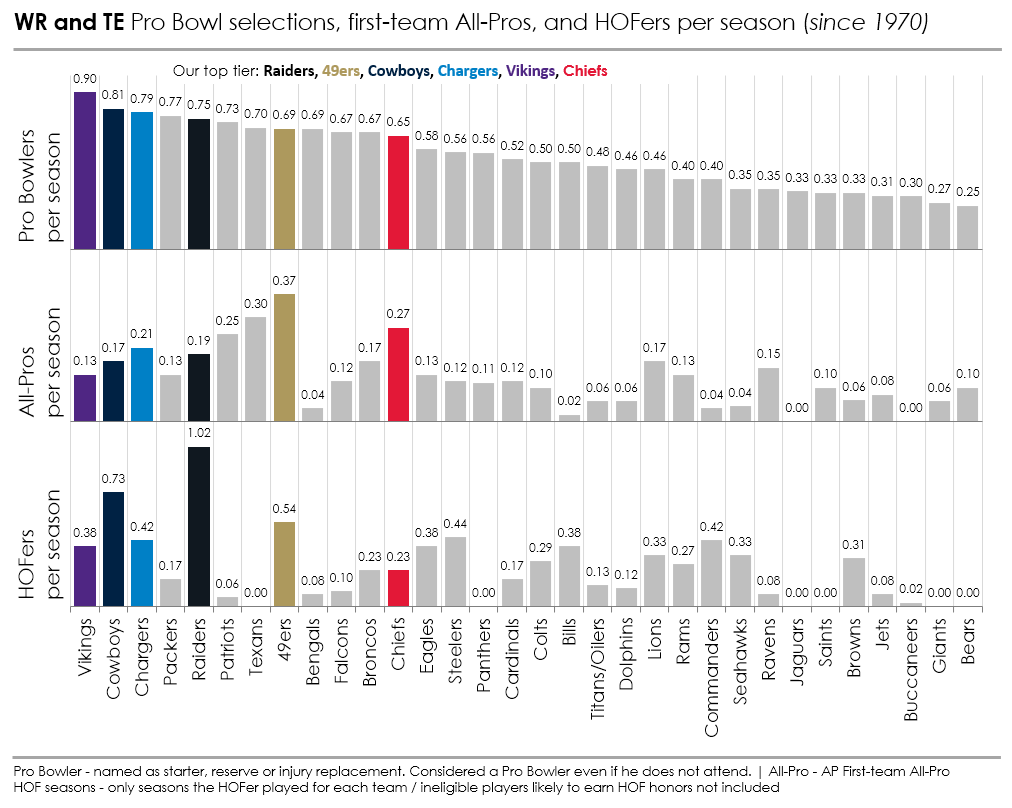
Las Vegas/Oakland/Los Angeles Raiders
When the NFL and AFL merged in 1970, the NFL inherited one of the most interesting teams in the league—the star-studded, hard-living, high-scoring Oakland Raiders. The Raiders led by legendary coach John Madden were coming off three straight seasons leading the AFL in points scored.
They would continue their offensive onslaught through the ‘70s and into the early ‘80s. For a significant part of the 1970s, the Raiders had three pass-catching Hall of Famers on the field at the same time in tight end Dave Casper, and wide receivers Cliff Branch and Fred Biletnikoff.
The Raiders had a top-five scoring offense eight times, and a top ten offense fourteen times while winning three Super Bowls and accumulating a 149-62-6 record during their first 15 seasons in the NFL. In the ‘70s, they averaged 2.3 Hall of Famers per season just from those positions.
Biletnikoff (Raiders from 1966-78) accumulated six Pro Bowls and two All-Pros, had 70 career post-season receptions, and more than 1,000 yards. Both were playoff career records at the time of his retirement. His playoff success peaked with a Super Bowl MVP in the 1976 season.
Casper aka “The Ghost” (Raiders 1974-80, 1984) was a first-team All-Pro in four consecutive seasons from 1976-79 and delivered one of the most famous plays in Raiders history, the “Ghost to the Post,” which helped the Raiders escape defeat in a 1977 AFC Divisional playoff game against the Baltimore Colts.
Branch (Raiders 1972-85) led the NFL in receiving yards in 1974 and receiving touchdowns in 1974 and 1976 while earning three first-team All-Pros. Branch, a small but fast receiver, ended his career with 17.3 yards per reception and was regularly in the top-10 in the league in yards per catch.
After Casper’s career ended, the Raiders transitioned from one great tight end to the next when they signed Todd Christensen in 1979. From 1983-1987 no player in the NFL caught more passes than Christensen (396). He led the league in receptions twice and made the Pro Bowl in all five seasons. He retired in 1988 with the fourth most career receptions by a tight end.
Hall of Fame wideout Tim Brown spent 16 seasons with the Raiders beginning in 1988. Even though the Raiders used him primarily on special teams his first four seasons, he still finished his career with the third most receptions in NFL history.
Once he became a full-time receiver, he strung together nine consecutive seasons with more than 1,000 yards and 10 straight seasons with at least 75 receptions. His career totals in receiving touchdowns (100), receptions (1,094) and receiving yards (14,934) are all still top-10 in history, 18 years after his retirement in 2004.
A few other all-time greats joined the Raiders for a cup of coffee. Jerry Rice, Randy Moss and James Lofton all spent 2-3 seasons with the Raiders although they are better known for their time with other teams. The Raiders have had a total of seven Hall of Fame pass catchers totaling 53 seasons with the team in the 52 years since the merger.
San Francisco 49ers
Every once in a while, a contrarian will throw a Johnny Unitas, Joe Montana or Otto Graham, at the GOAT discussion for quarterbacks, even though it’s undeniably Tom Brady. This is not the case for Jerry Rice.
The gap between Rice and the rest of the wide receivers is so vast, that not even the most daring contrarian would suggest introducing Chris Carter, Larry Fitzgerald or Randy Moss into the conversation.
With ten first-team All-Pro selections, Rice is tied with center Jim Otto for the most in history. He is number one in the NFL in receiving yards (22,895), receptions (1,549) and receiving touchdowns (197). The gap between Rice and the runner-up for receiving touchdowns is 41; this is greater than the gap between number two on the list (Randy Moss) and number seven on the list (Antonio Gates).
In Rice’s 16 years with the 49ers, they were a top-five scoring offense twelve times and were number one in the league six times while winning three Super Bowls. Rice was even better in the biggest moments with an 11-catch, 215 yards, one TD performance in Super Bowl XXIII, seven for 148 and three TDs in Super Bowl XXIV, and 10 for 149 and three TDs in Super Bowl XXIX.
In 1996, unheralded rookie Terrell Owens was drafted and enjoyed the benefit of playing with and learning from Jerry Rice. They played on the 49ers together for five years. In 2000, Rice’s last season with San Fransisco, Owens had a career-best 1,451 receiving yards and led the league in receiving yards per game with 103.6. This was his first of three consecutive first-team All-Pro seasons with the 49ers. The Hall of Famer ended his career ranked third in the NFL in receiving yards (15,934), eighth in receptions (1,078) and fifth in receiving touchdowns (156).
Before Rice and Owens, there was Dwight Clark, an above-average receiver with a couple of Pro Bowls and an All-Pro. But it was “The Catch,” one of the most iconic plays in NFL history, where Clark left his imprint on the league, and added to the great legacy of the 49ers' wide receivers.
Other Pro Bowl tight ends Ted Kwalick in the ‘70s, Brent Jones in the ‘90s, Vernon Davis in the ‘10s and George Kittle and many others further cement the 49ers as a top-tier franchise for wide receivers and tight ends.
Dallas Cowboys
In this article as well as our review of defensive positional groups the Cowboys are listed as the top tier in multiple categories. The pass-catching group is another positional group where they have separated itself from the rest of the league. It’s no surprise their two dynasties occurred when they had the bulk of their top pass-catchers.
The ‘70s dynasty began with “Bullet” Bob Hayes one of the fastest humans on earth and an Olympic gold medalist, gaining an off-the-charts 26.1 yards per reception. The 26.1 rate was the seventh best single-season rate in history and a post-merger record that hasn’t been surpassed. He followed that season with a 24.0 rate. The Hall of Famer wide receiver ended his career with 20.0 yards per reception, the sixth-best career rate in history and second best since the merger.
Most of Hayes’ best years were in the ‘60s, but he was the primary pass-catcher for Dallas in their 1971 Super Bowl winning season. As his career slowed down in 1973, undrafted rookie Drew Pearson joined the team.
The overlooked wide receiver became a three-time first-team All-Pro and a Hall of Famer. Much of the legacy he built came during his 21 playoff starts, the fourteenth most in history. His 50-yard touchdown reception to defeat the Vikings in a divisional playoff game with seconds remaining was the reason that “Hail Mary” a rarely used term in football, became a commonly used phrase in American football.
The Cowboys dynasty in the ‘90s featured a first-round draft pick who came in with high expectations and didn’t disappoint. Michael Irvin was drafted in 1988 but didn’t perform like the Hall of Famer he would become until 1991 when he exploded for a league-leading 1,523 yards.
From 1991-1995 he accumulated 7,093 receiving yards, second to only Jerry Rice during that period. During his five best seasons, the Cowboys won three Super Bowls. He is second in career receiving yards on the Cowboys behind probable Hall of Fame tight end Jason Witten.
In Witten’s 17-year career (16 with Dallas) he racked up the second most career receiving yards (13,046) and catches (1,228) by a tight end behind only Tony Gonzalez in both categories. One of the most dependable players in history, he didn’t miss a game for fourteen years in a row and ended up with 252 career starts—the 12th most in NFL history.
Adding to the stockpile of great pass-catching production through the years was Dez Bryant, who had a short but dominant peak from 2012-2014, an aging Terrell Owens who still put up three straight 1,000-yard seasons from age 33-35, tight end Jay Novacek who made five straight Pro Bowls with Dallas from 1991-95 and Tony Hill, who gained the third most receiving yards in Cowboys history from 1977-86.
For wide receivers and tight ends, the Cowboys have the second most seasons from Hall of Famers, the sixth most All-Pros and the second most Pro Bowlers in NFL history. Their exceptional wide receivers and tight ends are a significant factor in leading the franchise to a top-five scoring offense in more than one-third of all seasons since the merger.
A case can be made for…
Los Angeles/San Diego Chargers
Key Players: Charlie Joiner (HOF), Kellen Winslow (HOF), Antonio Gates, John Jefferson, Keenan Allen, Anthony Miller, Wes Chandler
Minnesota Vikings
Key Players: Randy Moss (HOF), Cris Carter (HOF), Ahmad Rashad, John Gilliam, Justin Jefferson
Kansas City Chiefs
Key Players: Tony Gonzalez (HOF), Travis Kelce, Tyreek Hill, Otis Taylor, Dwayne Bowe
Offensive Line
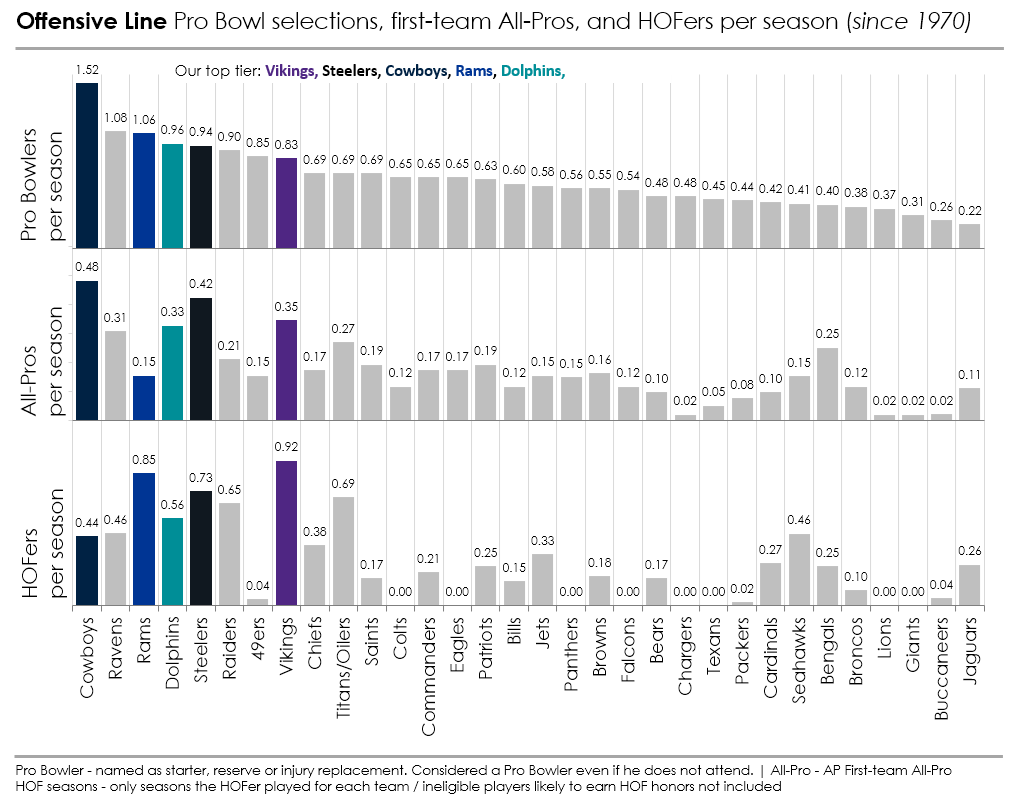
Minnesota Vikings
Iron sharpens iron. When a player’s job is to line up against the storied Purple People Eaters defensive line in practice each day like Hall of Famers Ron Yary (RT) and Mick Tingelhoff (C) had to do, the end result is a battle-tested unit that has experienced every challenge, trick, and tactic the rest of the league can throw at them.
Yary and Tingelhoff were a consistent and indispensable presence for the Vikings' offensive line in the 70s. During the ten years when their careers overlapped, the Vikings made the playoffs in nine seasons and reached four Super Bowls.
In quarterback Fran Tarkenton’s 18-year career he was only in the top-5 for lowest sack percentage four times; all four times came during the Tingelhoff/Yary era (1974-76, 1978). Tingelhoff started in 240 consecutive games—the most consecutive starts for a center. He made five first-team All-Pros, all of them coming before the merger, but he continued to start every game for the Vikings until he retired at the age of 38.
Yary was selected first-team All-Pro for six consecutive years from 1971 to 1976. Like Tingelhoff, Yary was also durable, starting every game and never missing time due to injury from 1970-1981.
The Vikings' league-leading 48 seasons with a Hall of Famer on the offensive line since the merger continued into the 1980s, 1990s and 2000s. Gary Zimmerman (LT) and Randall McDaniel (LG) played together fortifying the left side of the offensive line from 1988-1997.
They helped the Vikings reach the playoffs seven times in their 10 years together despite protecting five starting quarterbacks across the ten seasons. With Zimmerman retiring after 1997, McDaniel would continue to make Pro Bowls and contribute to team success as the Vikings averaged 12 wins per season and were top five in scoring each season from 1998-2000. McDaniel’s 12 career Pro Bowls and seven first-team All-Pros are the second most for an offensive lineman since the merger.
Continuing a tradition of excellence, center Matt Birk earned six Pro Bowls while merging the gap between Hall of Famers. He began his Vikings career playing beside the HOFer McDaniel and ended it playing beside Hall of Fame guard, Steve Hutchinson.
Hutchinson signed with the Vikings as a free agent in 2006 after five seasons with Seattle. Adding to the two All-Pros and three Pro Bowls he already earned with Seattle. He was selected to three more All-Pros and four Pro Bowls with Minnesota. Future HOFer Adrian Peterson averaged 1,400 rushing yards and 12 touchdowns a season from 2007-2011 running behind the offensive line led by Steve Hutchinson. Since 1970, the Vikings average an NFL-leading 0.92 Hall of Fame offensive linemen per season and, a third-best 0.35 All-Pros on the offensive line per season.
Pittsburgh Steelers
The center position has been one of the Steelers' biggest strengths throughout the decades. With Mike Webster, Dermontti Dawson and Maurkice Pouncey, no team has come close to matching the Steelers’ success.
In each of the six decades since the merger, the Steelers had a Pro Bowl center, giving them a total of 27 Pro Bowl seasons—12 more than the next closest team. In five of the last six decades, they had a first-team All-Pro center, giving them 14 All-Pros at the position—double the next closest team and giving them 26% of all All-Pros at center since 1970.
For 27 of the 52 seasons since 1970, the Steelers had a HOF center on their team—10 more than the next closest team and 32% of all combined Hall of Fame seasons in the NFL.
Webster was a full-time starter for the Steelers from 1976-88, winning two Super Bowls in the 1978 and 1979 seasons while leading the offensive line for a top-five scoring offense in both seasons. His nine career Pro Bowls are the most for a center since the merger, tied with another Steelers’ center, Maurkice Pouncey. His five first-team All-Pros are the second most for a center behind the other HOF Steeler, Dermontti Dawson.
1988 was Webster’s last season with the Steelers, and he started all 16 games at the age of 36. Dawson played at right guard that season, after being selected in the second round from Kentucky. At the time, no one would have guessed that the next Hall of Fame center was lined up right next to Webster on the offensive line.
Starting in 1989, Dawson didn’t miss a start for 10 straight seasons. During those 10 years, he made seven consecutive Pro Bowls and six consecutive first-team All-Pro selections, while helping to topple defenders for HOF running back Jerome Bettis who averaged 1,225 yards per season with Dawson.
A decade later, the Steelers drafted Pouncey in the first round of the 2010 draft. There have been only four centers drafted higher than Pouncey’s 18th overall spot since the merger. The Steelers Hall of Fame total of 27 seasons from the center position has a good chance of increasing by ten when Pouncey becomes eligible. His inclusion on the Pro Football Hall of Fame All-Decade Teams (2010s), his nine Pro Bowls and two first-team All-Pros give him a HOF-worthy resume.
The dominance doesn’t end at the center position. Hall of Famer Alan Faneca locked down the left guard position for the Steelers for ten seasons (1998-2007). He added a Super Bowl win to his list of accomplishments with a 21-10 win against Seattle in Super Bowl XL.
Faneca helped set the tone early in that Super Bowl with a third and goal block on Seattle linebacker LeRoy Hill giving quarterback Ben Roethlisberger just enough daylight to cross the goal line for a 1-yard TD run. Faneca was voted to the Pro Football Hall of Fame All-Decade Teams (2000s), along with nine Pro Bowls and six first-team All-Pros. The Steelers' great OL legacy includes other players such as David DeCastro, Alejandro Villanueva, Jeff Hartings and Tunch Ilkin.
Dallas Cowboys
Hall of Famer Rayfield Wright played for Dallas through the 1970s but was at his best through 1976. From 1970-79, Wright played in five Super Bowls and won two of them. He helped pave the way for running backs like Hill and Dorsett. Dallas would never have a season worse than a sixth-best ranking for total yards during Wright’s tenure with the team.
Hall of Famer, Larry Allen was drafted in 1994 during another Cowboys Dynasty. In 1995, his first full season as a starter, Allen made the Pro Bowl and helped Dallas go 12-4 and win Super Bowl XXX, 27-17 against the Steelers. Allen, known as one of the strongest players in NFL history, went on to make 10 Pro Bowls and six first-team All-Pros with Dallas.
Tyron Smith, Nate Newton, Andre Gurode, Flozell Adams, Travis Frederick and current guard Zack Martin add to the countless list of great offensive linemen to play for the Cowboys. Zack Martin is coming off another All-Pro season, his fifth, and hopes to continue playing at a high level. Last season, at age 31, he had his best season ever according to Pro Football Focus with a PFF grade of 93.9.
Since the merger, Dallas has had more Pro Bowl offensive linemen than any other team with a total of 79. They average 1.5 Pro Bowlers on their offensive line every year. In 20% of their seasons since 1970, they have had as many as three Pro Bowlers on the offensive line. This includes 1995-96 when they had four each season. The Cowboys' five Super Bowls in the 1970s and three Super Bowls in the 1990s were a team effort led by many superstars, but the offensive line played no small part in building the Cowboys' winning tradition.
A case can be made for…
Los Angeles Rams
Key Players: Jackie Slater (HOF), Orlando Pace (HOF), Tom Mack (HOF) Rich Saul, Doug Smith, Dennis Harrah, Kent Hill, Tom Newberry
Miami Dolphins
Key Players: Dwight Stephenson (HOF), Jim Langer (HOF), Larry Little (HOF), Richmond Webb, Bob Kuechenberg, Jake Long, Ed Newman, Larry Little
Jason Pauley contributed to this report.

